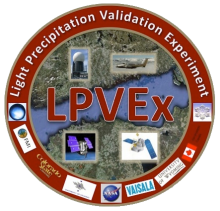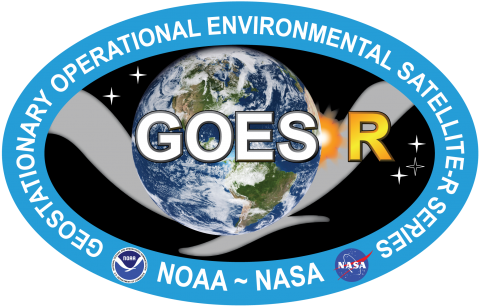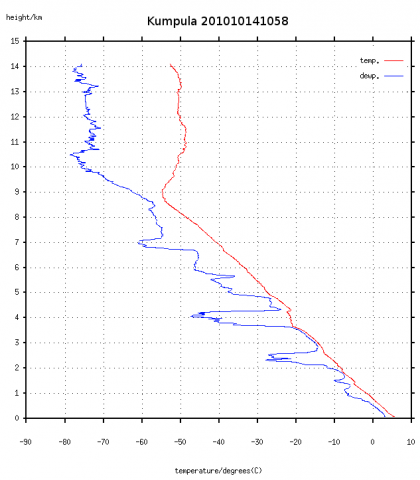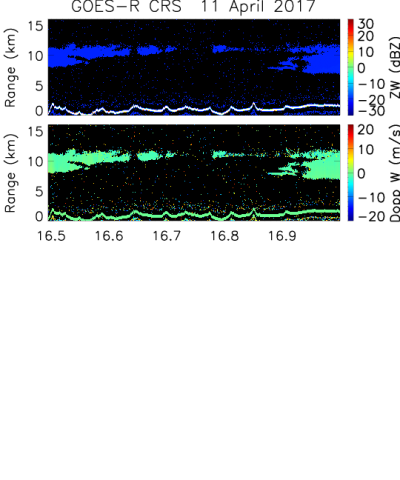 The Global Hydrology Resource Center (GHRC) DAAC published the GPM Ground Validation Micro Rain Radar (MRR) LPVEx dataset. This dataset was collected during the Global Precipitation Measurement (GPM) mission Ground Validation Light Precipitation Validation Experiment (LPVEx) field campaign. The LPVEx field campaign took place around the Gulf of Finland in September and October of 2010. The goal of the campaign was to provide additional high altitude, light rainfall measurements for the improvement of GPM satellite precipitation algorithms. The MRR is a Biral/Metek 24 GHz (K-band) vertically oriented Frequency Modulated Continuous Wave (FM-CW) radar that measures signal backscatter from which Doppler spectra, radar reflectivity, Doppler velocity, drop size distribution, rain rate, liquid water content, and path integrated attenuation are derived. The dataset contains measured and derived data from MRR instruments placed at four remote sites (Jarvenpaa, Emasalo, Harmaja, and the research vessel Aranda). Data files are available in ASCII data format. It should be noted that this dataset contains MRR data during the LPVEx field campaign. A few of the sites have MRR operation before and after the field campaign: May 2010 (Aranda and Jarvenpaa), and November 2010 through March 2011 (Jarvenpaa). These data are also included in the dataset. In the beginning of September 2010, the feed of the MRR at Jarvenpaa was oriented towards the C-band weather radar of the site, and that caused some extra interference, particularly during PPI scans once every hour. Before the active measurements of LPVEx campaign the feed was oriented away from the weather radar, and no significant interference from that source appeared anymore. On 9 November, 2010, components from the MRR deployed at Emasalo were relocated to Jarvenpaa and used to deploy a second MRR ("MRR2") at that site. When the radar was redeployed as the Jarvenpaa MRR2, the vertical resolution was changed from 100 m to 15 m.
The Global Hydrology Resource Center (GHRC) DAAC published the GPM Ground Validation Micro Rain Radar (MRR) LPVEx dataset. This dataset was collected during the Global Precipitation Measurement (GPM) mission Ground Validation Light Precipitation Validation Experiment (LPVEx) field campaign. The LPVEx field campaign took place around the Gulf of Finland in September and October of 2010. The goal of the campaign was to provide additional high altitude, light rainfall measurements for the improvement of GPM satellite precipitation algorithms. The MRR is a Biral/Metek 24 GHz (K-band) vertically oriented Frequency Modulated Continuous Wave (FM-CW) radar that measures signal backscatter from which Doppler spectra, radar reflectivity, Doppler velocity, drop size distribution, rain rate, liquid water content, and path integrated attenuation are derived. The dataset contains measured and derived data from MRR instruments placed at four remote sites (Jarvenpaa, Emasalo, Harmaja, and the research vessel Aranda). Data files are available in ASCII data format. It should be noted that this dataset contains MRR data during the LPVEx field campaign. A few of the sites have MRR operation before and after the field campaign: May 2010 (Aranda and Jarvenpaa), and November 2010 through March 2011 (Jarvenpaa). These data are also included in the dataset. In the beginning of September 2010, the feed of the MRR at Jarvenpaa was oriented towards the C-band weather radar of the site, and that caused some extra interference, particularly during PPI scans once every hour. Before the active measurements of LPVEx campaign the feed was oriented away from the weather radar, and no significant interference from that source appeared anymore. On 9 November, 2010, components from the MRR deployed at Emasalo were relocated to Jarvenpaa and used to deploy a second MRR ("MRR2") at that site. When the radar was redeployed as the Jarvenpaa MRR2, the vertical resolution was changed from 100 m to 15 m.GHRC News
 The Global Hydrology Resource Center (GHRC) DAAC published the GPM Ground Validation Micro Rain Radar (MRR) LPVEx dataset. This dataset was collected during the Global Precipitation Measurement (GPM) mission Ground Validation Light Precipitation Validation Experiment (LPVEx) field campaign. The LPVEx field campaign took place around the Gulf of Finland in September and October of 2010. The goal of the campaign was to provide additional high altitude, light rainfall measurements for the improvement of GPM satellite precipitation algorithms. The MRR is a Biral/Metek 24 GHz (K-band) vertically oriented Frequency Modulated Continuous Wave (FM-CW) radar that measures signal backscatter from which Doppler spectra, radar reflectivity, Doppler velocity, drop size distribution, rain rate, liquid water content, and path integrated attenuation are derived. The dataset contains measured and derived data from MRR instruments placed at four remote sites (Jarvenpaa, Emasalo, Harmaja, and the research vessel Aranda). Data files are available in ASCII data format. It should be noted that this dataset contains MRR data during the LPVEx field campaign. A few of the sites have MRR operation before and after the field campaign: May 2010 (Aranda and Jarvenpaa), and November 2010 through March 2011 (Jarvenpaa). These data are also included in the dataset. In the beginning of September 2010, the feed of the MRR at Jarvenpaa was oriented towards the C-band weather radar of the site, and that caused some extra interference, particularly during PPI scans once every hour. Before the active measurements of LPVEx campaign the feed was oriented away from the weather radar, and no significant interference from that source appeared anymore. On 9 November, 2010, components from the MRR deployed at Emasalo were relocated to Jarvenpaa and used to deploy a second MRR ("MRR2") at that site. When the radar was redeployed as the Jarvenpaa MRR2, the vertical resolution was changed from 100 m to 15 m.
The Global Hydrology Resource Center (GHRC) DAAC published the GPM Ground Validation Micro Rain Radar (MRR) LPVEx dataset. This dataset was collected during the Global Precipitation Measurement (GPM) mission Ground Validation Light Precipitation Validation Experiment (LPVEx) field campaign. The LPVEx field campaign took place around the Gulf of Finland in September and October of 2010. The goal of the campaign was to provide additional high altitude, light rainfall measurements for the improvement of GPM satellite precipitation algorithms. The MRR is a Biral/Metek 24 GHz (K-band) vertically oriented Frequency Modulated Continuous Wave (FM-CW) radar that measures signal backscatter from which Doppler spectra, radar reflectivity, Doppler velocity, drop size distribution, rain rate, liquid water content, and path integrated attenuation are derived. The dataset contains measured and derived data from MRR instruments placed at four remote sites (Jarvenpaa, Emasalo, Harmaja, and the research vessel Aranda). Data files are available in ASCII data format. It should be noted that this dataset contains MRR data during the LPVEx field campaign. A few of the sites have MRR operation before and after the field campaign: May 2010 (Aranda and Jarvenpaa), and November 2010 through March 2011 (Jarvenpaa). These data are also included in the dataset. In the beginning of September 2010, the feed of the MRR at Jarvenpaa was oriented towards the C-band weather radar of the site, and that caused some extra interference, particularly during PPI scans once every hour. Before the active measurements of LPVEx campaign the feed was oriented away from the weather radar, and no significant interference from that source appeared anymore. On 9 November, 2010, components from the MRR deployed at Emasalo were relocated to Jarvenpaa and used to deploy a second MRR ("MRR2") at that site. When the radar was redeployed as the Jarvenpaa MRR2, the vertical resolution was changed from 100 m to 15 m. The NASA Global Hydrology Resource Center (GHRC) DAAC published the GOES-R Post Launch Test (PLT) ER-2 aircraft flight navigation data set. This data set consists of multiple altitude, pressure, temperature parameters, airspeed, and ground speed measurements collected by the NASA ER-2 high-altitude aircraft for flights that occurred during the GOES-R Post Launch Test (PLT) field campaign. The GOES-R PLT airborne science field campaign took place between March 21 and May 17, 2017 in support of the post-launch product validation of the Advanced Baseline Imager (ABI) and the Geostationary Lightning Mapper (GLM). ER-2 navigation data files in ASCII-IWG1 format are available for March 21, 2017 through May 17, 2017.
The NASA Global Hydrology Resource Center (GHRC) DAAC published the GOES-R Post Launch Test (PLT) ER-2 aircraft flight navigation data set. This data set consists of multiple altitude, pressure, temperature parameters, airspeed, and ground speed measurements collected by the NASA ER-2 high-altitude aircraft for flights that occurred during the GOES-R Post Launch Test (PLT) field campaign. The GOES-R PLT airborne science field campaign took place between March 21 and May 17, 2017 in support of the post-launch product validation of the Advanced Baseline Imager (ABI) and the Geostationary Lightning Mapper (GLM). ER-2 navigation data files in ASCII-IWG1 format are available for March 21, 2017 through May 17, 2017. The NASA Global Hydrology Resource Center (GHRC) DAAC published the Global Precipitation Measurement (GPM) mission ground validation Light Precipitation Validation Experiment (LPVEx) radiosonde data set. The Vaisala radiosondes were used to produce vertical profiles of atmospheric temperature, pressure, humidity, and winds. The radiosondes were launched from two locations: Kumpula and Vantaa, Finland. The LPVEx field campaign took place around the Gulf of Finland in September and October, 2010. However, the Vantaa launch site record extends through January 2011. The campaign was to provide additional high altitude, light rainfall measurements for the improvement of GPM satellite precipitation algorithms. Data files are available in TSV format with PNG browse images. Data are available from September 15, 2010 through January 28, 2011.
The NASA Global Hydrology Resource Center (GHRC) DAAC published the Global Precipitation Measurement (GPM) mission ground validation Light Precipitation Validation Experiment (LPVEx) radiosonde data set. The Vaisala radiosondes were used to produce vertical profiles of atmospheric temperature, pressure, humidity, and winds. The radiosondes were launched from two locations: Kumpula and Vantaa, Finland. The LPVEx field campaign took place around the Gulf of Finland in September and October, 2010. However, the Vantaa launch site record extends through January 2011. The campaign was to provide additional high altitude, light rainfall measurements for the improvement of GPM satellite precipitation algorithms. Data files are available in TSV format with PNG browse images. Data are available from September 15, 2010 through January 28, 2011. The NASA Global Hydrology Resource Center (GHRC) DAAC published the GOES-R Post Launch Test (PLT) Cloud Radar System (CRS) dataset. The CRS provides high-resolution profiles of reflectivity and Doppler velocity at aircraft nadir along the flight track. The CRS was flown aboard a NASA ER-2 high-altitude aircraft during the GOES-R Post Launch Test (PLT) field campaign. The campaign took place from March to May 2017 in support of post-launch L1b and L2+ product validation of the Advanced Baseline Imager (ABI) and the Geostationary Lightning Mapper (GLM). Data files in netCDF-3 format are available for April 11, 2017 through May 17, 2017.
The NASA Global Hydrology Resource Center (GHRC) DAAC published the GOES-R Post Launch Test (PLT) Cloud Radar System (CRS) dataset. The CRS provides high-resolution profiles of reflectivity and Doppler velocity at aircraft nadir along the flight track. The CRS was flown aboard a NASA ER-2 high-altitude aircraft during the GOES-R Post Launch Test (PLT) field campaign. The campaign took place from March to May 2017 in support of post-launch L1b and L2+ product validation of the Advanced Baseline Imager (ABI) and the Geostationary Lightning Mapper (GLM). Data files in netCDF-3 format are available for April 11, 2017 through May 17, 2017. The NASA Global Hydrology Resource Center (GHRC) DAAC participated in its annual Earthdata webinar. This is an activity that each DAAC participates in to showcase updates and capabilities. This year, the GHRC presented, “Using the ISS Lightning Imaging Sensor and Release of the GOES-R Post Launch Test Observations.” The webinar started with background information about GHRC. The main body of the presentation focused on the International Space Station Lightning Imaging Sensor (ISS LIS). This included information about the importance of lightning observations and physical reasoning. Information, including a live demonstration, was provided on how to access and download these data. The final part of the ISS LIS section focused on a lightning exposure risk study in Bangladesh and Nepal through the NASA DEVELOP program. The webinar concluded with the announcement of the GOES-R Post Launch Test field campaign data and a description of this campaign.
The NASA Global Hydrology Resource Center (GHRC) DAAC participated in its annual Earthdata webinar. This is an activity that each DAAC participates in to showcase updates and capabilities. This year, the GHRC presented, “Using the ISS Lightning Imaging Sensor and Release of the GOES-R Post Launch Test Observations.” The webinar started with background information about GHRC. The main body of the presentation focused on the International Space Station Lightning Imaging Sensor (ISS LIS). This included information about the importance of lightning observations and physical reasoning. Information, including a live demonstration, was provided on how to access and download these data. The final part of the ISS LIS section focused on a lightning exposure risk study in Bangladesh and Nepal through the NASA DEVELOP program. The webinar concluded with the announcement of the GOES-R Post Launch Test field campaign data and a description of this campaign.









